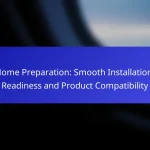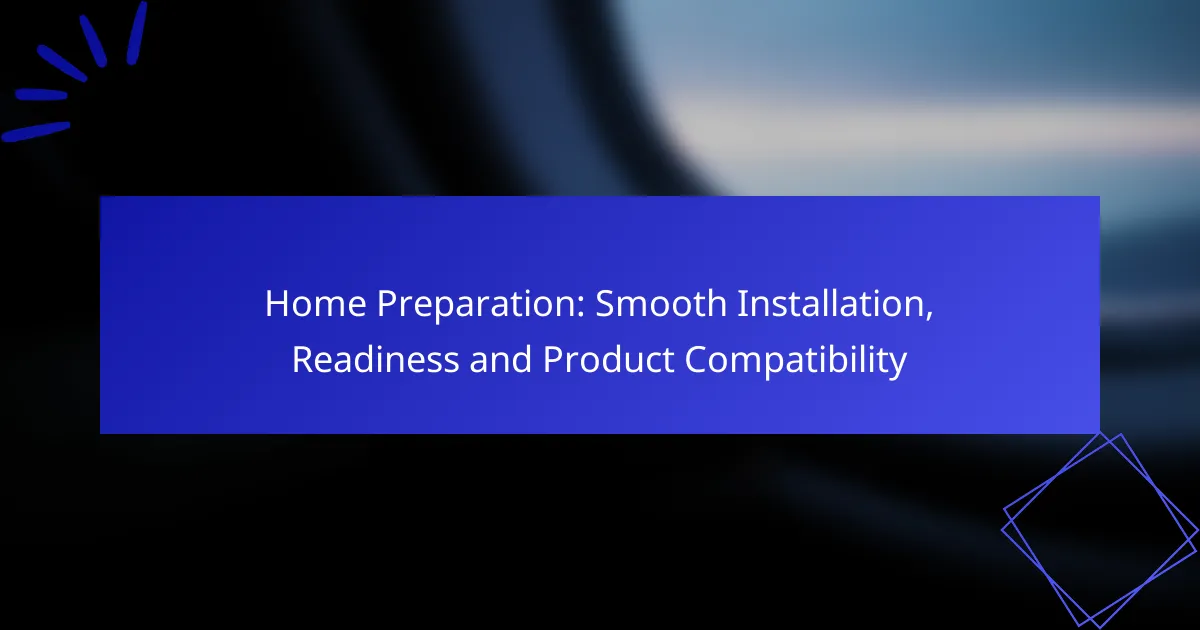Preparing your home for installation is crucial for a seamless experience, requiring careful organization of the space and verification of your electrical and plumbing systems. Ensuring compatibility among your chosen products, such as smart devices and appliances, can significantly enhance your home’s functionality. By addressing potential challenges early, you can avoid delays and ensure a smooth installation process.

How to prepare your home for a smooth installation?
Preparing your home for a smooth installation involves organizing the space, ensuring you have the right tools, and confirming that your electrical and plumbing systems are ready. Taking these steps will help avoid delays and complications during the installation process.
Clear installation area
Clearing the installation area is crucial for a hassle-free setup. Remove any furniture, decorations, or obstacles that could impede access to the installation site. This not only creates a safer environment but also allows the installer to work efficiently.
Consider measuring the space to ensure that the new product will fit properly. If necessary, create a designated area for tools and materials to keep everything organized during the installation.
Gather necessary tools
Having the right tools on hand can significantly streamline the installation process. Common tools might include screwdrivers, wrenches, pliers, and a level. Check the installation manual for any specific tools that may be required.
It’s wise to gather these tools ahead of time to avoid interruptions. If you lack any tools, consider borrowing or purchasing them before the installation date.
Check electrical and plumbing systems
Before installation, ensure that your electrical and plumbing systems are in good working order. For electrical installations, verify that outlets are functional and that the circuit can handle the load of the new appliance. If you’re installing plumbing fixtures, check for leaks or blockages.
Consult a professional if you notice any issues, as addressing them beforehand can prevent complications during installation. This step is essential for compliance with safety standards and regulations.
Review installation guidelines
Thoroughly reviewing the installation guidelines provided by the manufacturer is essential. These guidelines offer specific instructions tailored to the product, including any unique requirements or precautions. Understanding these details can help you prepare the installation area effectively.
Take note of any special tools or techniques mentioned in the guidelines. Familiarizing yourself with the process can also help you communicate better with the installer, ensuring a smoother experience.
Schedule installation time
Scheduling the installation at a convenient time is key to ensuring that everything goes smoothly. Choose a time when you can be present to oversee the process and address any questions the installer may have. This is especially important for complex installations that may require your input.
Consider the availability of the installer and your own schedule when setting the date. It’s often best to allow for a buffer period in case unexpected issues arise during the installation.

What products are compatible with my home setup?
Compatibility with your home setup depends on the types of products you intend to use, including smart devices, appliances, heating and cooling systems, and the materials of your flooring and walls. Ensuring that these elements work together can enhance functionality and efficiency in your home.
Smart home devices compatibility
Smart home devices must be compatible with your existing network and each other to function effectively. Look for devices that support common standards like Wi-Fi, Zigbee, or Z-Wave to ensure seamless integration.
Before purchasing, check if the devices are compatible with your smart home hub or voice assistant, such as Amazon Alexa or Google Assistant. This will help avoid connectivity issues and enhance user experience.
Appliance size and specifications
When selecting appliances, consider their size and specifications to ensure they fit your space and meet your power requirements. Measure the designated area accurately, accounting for clearance and ventilation needs.
Check the voltage and amperage ratings of appliances to match your home’s electrical system, typically 120V or 240V in the U.S. This prevents potential electrical hazards and ensures optimal performance.
Heating and cooling system compatibility
Your heating and cooling systems should be compatible with any new devices or appliances you plan to install. For instance, smart thermostats need to work with your HVAC system’s voltage and wiring.
Consider the efficiency ratings of your heating and cooling systems, as newer devices may require systems that meet or exceed certain energy efficiency standards to function optimally.
Flooring and wall material considerations
The materials of your flooring and walls can affect the installation and performance of various products. For example, certain smart devices may require specific mounting hardware that works best with drywall or concrete.
Additionally, consider how flooring materials like tile or hardwood may impact the installation of appliances or smart devices. Ensure that any devices installed on walls or floors are suitable for the material to avoid damage or instability.

What are the common installation challenges?
Common installation challenges include space limitations, inadequate power supply, improper measurements, and unexpected structural issues. Addressing these factors early can help ensure a smoother installation process and better compatibility with your chosen products.
Space limitations
Space limitations can significantly hinder the installation of appliances or systems. Before starting, measure the area where the installation will occur to ensure there is enough room for the product and any necessary accessories.
Consider not only the dimensions of the product but also the space required for ventilation and access for maintenance. A common pitfall is underestimating the clearance needed for doors or panels to open fully.
Inadequate power supply
An inadequate power supply can lead to installation delays or even equipment failure. Check the electrical requirements of your product, including voltage and amperage, and compare them with your existing electrical system.
If your home’s electrical system cannot support the new installation, you may need to upgrade your wiring or circuit breakers, which can add to the overall cost and time of the project.
Improper measurements
Improper measurements can result in products that do not fit or function as intended. Always use a reliable measuring tool and double-check your measurements before making any purchases or cutting materials.
When measuring, consider not just the product dimensions but also any additional space needed for installation tools and future maintenance access. A good practice is to create a detailed layout plan to visualize the installation.
Unexpected structural issues
Unexpected structural issues can arise during installation, such as hidden plumbing or electrical lines. Conduct a thorough inspection of the installation area before starting, and consider consulting a professional if you suspect complications.
Be prepared for potential adjustments to your installation plan if structural issues are discovered. Having a contingency budget and timeline can help mitigate the impact of these unforeseen challenges.

How to assess product readiness for installation?
Assessing product readiness for installation involves checking compatibility, ensuring all necessary components are included, and confirming warranty details. This preparation helps avoid delays and ensures a smooth installation process.
Check for missing components
Before installation, verify that all components listed in the product manual are present. Missing parts can lead to incomplete setups or functionality issues.
Create a checklist of essential items, such as screws, brackets, and tools, to ensure nothing is overlooked. If any components are missing, contact the supplier for replacements as soon as possible.
Verify warranty and return policies
Understanding the warranty and return policies is crucial for protecting your investment. Check the duration of the warranty and what it covers, including parts and labor.
Familiarize yourself with the return process in case the product does not meet your expectations. Keep receipts and documentation handy, as they may be required for claims or returns.
Inspect for damages
Examine the product for any visible damages before installation. Look for dents, scratches, or broken parts that could affect performance or safety.
If you find any issues, document them with photos and report them to the retailer or manufacturer immediately. Prompt action can help you secure a replacement or repair without incurring additional costs.

What are the best practices for product compatibility?
Ensuring product compatibility is crucial for a smooth installation and optimal performance. Best practices include consulting manufacturer specifications and utilizing compatibility checkers to avoid issues and ensure that all components work seamlessly together.
Consult manufacturer specifications
Manufacturer specifications provide essential information about product compatibility, including supported models, required accessories, and installation guidelines. Always check these details before purchasing to prevent mismatches that could lead to installation failures.
For example, if you’re installing a new appliance, verify its compatibility with existing electrical systems or plumbing. This can save you time and money by avoiding the need for additional modifications or replacements.
Use compatibility checkers
Compatibility checkers are online tools or software designed to help users determine if products will work together. These tools typically require you to input the model numbers or specifications of the items you wish to pair.
Many retailers and manufacturers offer these checkers on their websites. Utilizing them can streamline your decision-making process and reduce the risk of purchasing incompatible products. Always double-check results against manufacturer specifications for added assurance.






